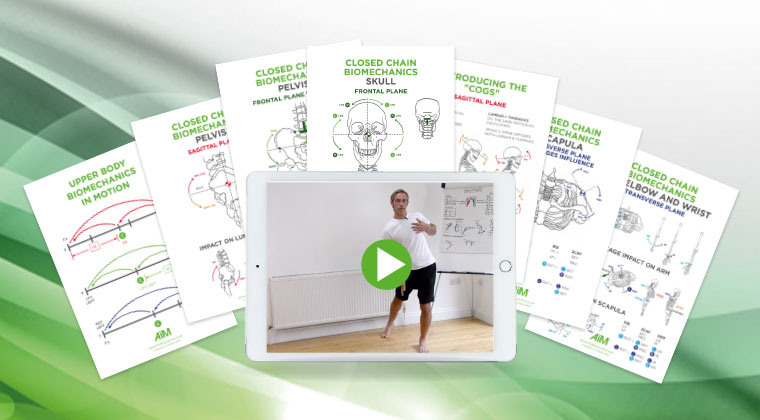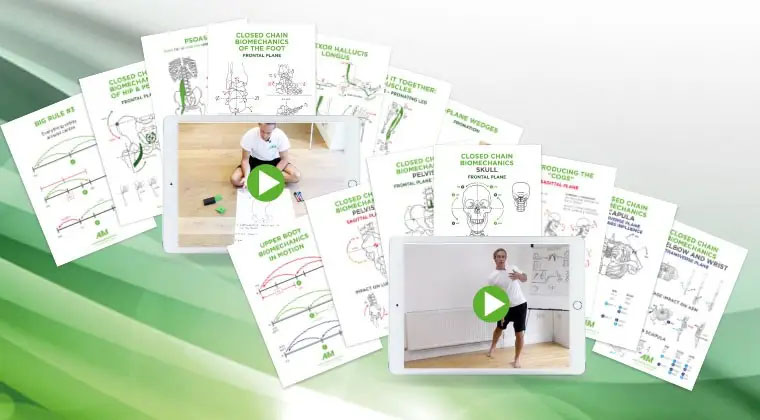DIY ONLINE PROGRAMMES
Our online programmes are the quickest way to begin learning the ground breaking work of Gary Ward & Anatomy in Motion taking you from the important fundamentals of Closed Chain Biomechanics to the Flow Motion Model. The three programmes ‘Lower Limb’, ‘Upper Body’ and ‘Assessments’ equate to doing Module 1 of the Live courses. With successful completion of these courses you wil lbe eligible to sign up for a live FMM course

BUY ALL THREE ONLINE COURSES
Three Online programmes:
Closed Chain Biomechnics of the Lower Limb, Biomechanics of the Upper Body in Motion and Lower & Upper Body Assessments. These courses cover all of the joint mechanics, muscle reactions and joint integrations that come together to form key shapes in the body, critical for efficient and optimal movement through the gait cycle. Later we will see in the Flow Motion Model course exactly how these joint motions and body shapes come together to create a flowing, efficient and effortless gait. The latest addition is the assessment piece where Gary assesses a real person and ties together the two main programmes.
Supported by video, PDF manuals, first class anatomcial illustrations, quizzes and awarding CPD / CEU points for most awarding bodies.
This is your opportunity to learn the foundtions of the Flow Motion Model in your own space and time. Enjoy!
Read more about what’s in the bundle below…

Closed Chain Biomechanics of the Lower Limb
Closed Chain Biomechanics of the Lower Limb is your introduction into the pure biomechanics of three dimensional movement in the joints of the foot, ankle and leg when engaged with the ground.
This course includes 10 hours of content covering:
- An in-depth and unique insight into the biomechanics of the pelvis, hip, knee, ankle and foot when upright and in motion.
- Joints ACT: Muscles REACT: an observation of how major muscles respond in 3D to specific joint motions
- How these joint motions integrate together to form two key leg shapes
- How to use AiM Wedges to restore ‘missing’ motion in the limb
- Preparing you to observe and understand the role of the lower limb in gait and the Flow Motion Model
- Includes a Quiz and CPD points

Biomechanics of the Upper Body in Motion
Take a deep dive into the 3D biomechanics of the Upper body, including, pelvis, ribcage, skull , spine and shoulder girdle when the body is upright and in motion.
This course includes 10 hours of content covering:
- The possibilities for movement at the pelvis, ribcage and skull when the foot is on the ground
- The impact these movements will have on the lumbar, thoracic and cervical spine.
- How these structures come together to formulate 8 unique body shapes (none of which are neutral).
- Observation of the arms and shoulder girdle and how they respond to the spine and ribcage’s resting position.
- Preparing you to observe and understand the role of the upper body in gait and the Flow Motion Model
- Includes a Quiz and CPD points

Lower & Upper Body Assessment For Closed Chain Biomechanics Of The Upper Body In Motion
This course is designed to bring together the Lower Limb and Upper Body online programmes. In this third programme Gary introduces a process of how to assess both resting and dynamic posture, using the mechanics taught in the first two programmes. The approach centers around the idea that we should have access to all available joint motions and many people simply do not. THis simple assessment procedure will highlight what motions and individual is missing and in which resting position of each joint those movement limitations exist. Having the capacity to assess these body parts creates a thought process to clearly begin working with the Human Body in motion and prepares you fully for the next step in the journey: Building the Flow Motion Model.
- Includes CPD points

The Flow Motion Model
Coming Soon
In this fourth online programme Gary creates an environment for students to go through the steps he went through in order to build his Flow Motion Model. The course introduces the theory and philosophy that backs up the model, introduces the key concepts upon which the Model is founded and understood and guides you through a phase by phase process for unravelling the optimal movement journey of each and every joint and structure in three dimensions through a single footstep… a journey that lasts 0.6 to 0.8 seconds. Together we will walk through the model and observe real gait analyses to see the model come to life. When you bring your assessment and joint mechanics insight from the first three programmes and combine with the Flow Motion Model, you will begin to see which phases a person is dominant in and whch phases they struggle to access which will guide us toward specific movement solutions for indivuals seeking help with their body.
Coming Soon
Comments are closed.
